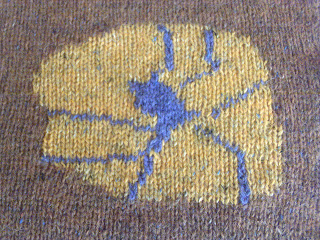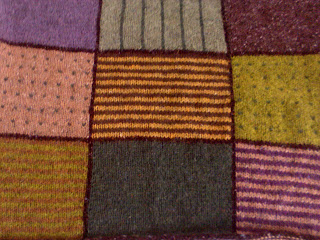This week I have completed the
piece of my quilt which is dedicated to the professional soldiers. Some of them died during the war – and some
of them fought throughout – and came home injured mentally and/or physically.
When I first thought about
designing a piece for the men who were soldiers before the war started – I
first thought about doing interlocking crosses.
Then I thought about doing a “toy soldier” but I didn’t want to belittle
their efforts. When I think of soldiers
I tend to think of shiny buttons and polished boots and being killed. Then I remembered the songs that the soldiers
use to sing. I considered them but then
settled on using the song - Where Have All
the Flowers Gone? as inspiration.

This design consists of 4 rows of
5 regular blocks of colour, but each row of blocks means something to me. The first row of blue blocks represents blue
collar workers or ordinary working class men.
The next row – is a row of soldiers.
The third row represents gravestones, and the last row – flowers. I know it is a bit morbid – but then the
whole quilt is a bit morbid. I am sure
when you looked at this piece of knitting for the first time – you thought
“that is attractive” rather than “that is morbid”!
For this piece I cast on 67sts
and knit 165 rows. Each block is 7sts
wide and 30 rows high – 15 rows of each shade.
There are 6sts between blocks, 4sts each side, 10 rows between blocks –
with 8 at the beginning and 7 at the end.
It was quite easy to knit because I wound the colours onto bobbins – so
I didn’t get as tangled up as usual.
To come back to the title for the
piece – it is called Edward to remember my great great uncle Edward Benn. He was not a blood relative but married to my
great great aunt Elizabeth Longhurst. He
was a private in 23rd battalion of the London Regiment who was
killed on 13 November 1916 aged 26. My
grandma told me about his small son Teddy – who she used to find tucked in at
the bottom of her bed when her aunt had turned to her sister for support. Very sadly Elizabeth lost Teddy in the World
War 2.
This piece is also to remember my
third cousin, twice removed: Herbert Victor Jones who was a corporal in the 1st
battalion of the Duke of Cornwall’s Light infantry who died on 8 May 1917 aged
25 and my fourth cousin, four times removed: William Edward Morrish who was a
soldier in India before the war and who died on 24 July 1915 aged 30, a CQMS in
the 2nd battalion of the Queens Own Royal West Kent Regiment.
This piece is also dedicated to
my fourth cousin, twice removed: Henry Thomas (Harry) Hamlyn who was a soldier
as early as 1911 – he was a private in the 2nd battalion of the
Devonshire Regiment who died on 1 July 1916 – the first day of the battle of
the Somme – aged 23. He was one of three
brothers who were all killed in the war.
I would also like to mention my
great grandfather Frank Henry Taylor and his brother-in-law Sam Drew who both
came from a military background, fought throughout the war and returned
home. Frank was invalided out of the
army and Sam went on to join the Merchant Navy – I don’t think civilian life
suited Sam. I should also remember all
those other soldiers who fought and returned home deeply affected by their
experiences.


















